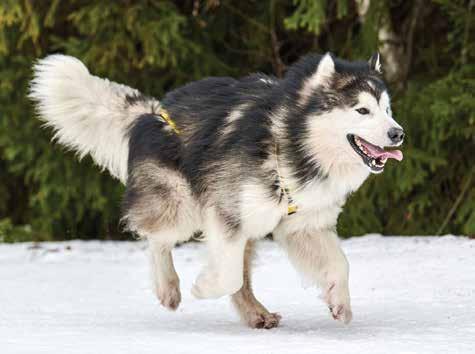
7 minute read
Alternatively Speaking: The ABC’s of Vitamin D Dr. Anne Carroll DVM, CVA
Alternatively Speaking: The ABC’s of Vitamin D

Advertisement
Dr. Anne Carroll DVM, CVA
Ah, winter. Time for glistening snow-covered landscapes, ice skating, snowmen… and for those of us indoors by the fire more than out in the little sun we have, time to think about our Vit D levels! This discussion may be especially pertinent this year, since among its many benefits Vit D promotes a healthy immune system for avoiding infectious disease, or reducing symptoms and duration of illness. Researchers are still investigating what this may mean for COVID, and while cases of COVID in dogs and cats are astronomically rare, and ‘one-way’ from people to pets when they do occur, Vit D is equally important for them in many other ways. So now seems a good time to talk about the role this vitamin plays in our pet’s health, and how we can ensure they have sufficient levels of this very important nutrient.
Why do we care so much about Vit D? It is most well-known for its role in calcium regulation and bone growth, with deficiency causing Rickets in growing children. But there are more than 2000 genes in tissues and organs in the body that are influenced by Vit D, and it has been shown to play a role in human cardiovascular disease, hypertension, cancer, diabetes, multiple sclerosis, rheuWinter 2021


matoid arthritis, and asthma. Growing animals can get Rickets too, and Vit D has as far-reaching effects for them as in people. Low Vit D has been associated with chronic kidney disease, inflammatory bowel disease, cardiovascular disease, infection, dental erosions in cats, allergies, and yes, cancer.
In fact, a good deal of research focuses on low Vit D and cancer for us and our pets. Vit D’s actions are anti-inflammatory. When Vit D is low, measures of inflammation like C-reactive protein are high. Inflammation is a known risk factor for cancer since it contributes to its development, progression, and prognosis. Beyond being anti-inflammatory, this vitamin impacts genes controlling cell growth, reproduction, and most other functions cancers need to spread and change tissues. Low Vit D has been associated with the risk of breast, colon, and prostate cancer in people, while in our skin it helps reduce skin cancer by decreasing susceptibility to UV rays. In animals, deficiency has been associated with mast cell, hemangiosarcoma, and lymphoma cancers.
While it’s true that the benefit of Vit D is similar in pets and humans, things start to be different when we compare where our Vit D comes from. Humans, sheep, and cattle can produce Vit D3 in the skin. However enzymes in dog and cat skin convert Vit D precursors to cholesterol, not Vit D, so photosynthesis provides them very little. For a fun fact, chickens don’t make Vit D in their skin either, but sunlight does make it in the feather’s oil which the birds ingest while grooming. No matter how Vit D is obtained, it is stored in body fat including in muscles and organs, and that fat is the natural source of Vit D for predators including dogs and cats.
However, In modern times pets eat more commercial foods than fresh prey. The process of converting ingredients into pet food destroys so many of the original nutrients, supplements like Vit D must be added. Unfortunately, AFFCO guidelines for Vit D, like many nutrients, require pet food to have the minimum to avoid clinical disease (like Rickets during growth), but not so much as to cause toxicity. Survival is great, but there is far too little research to show what amount is actually ideal for adult animals to thrive. Even in people guidelines are constantly being revised, as studies are now looking at many mineral and hormonal levels in the body to decide how much supplementation is needed for optimal blood levels of this very important nutrient.





So how can you optimize the Vit D in your pet’s food? In our practice, we discuss adding some fresh foods to try to mimic the content of a natural diet. As always, discussing your individual animal’s needs with your veterinarian is the place to start before adjusting their food, but in general, it is safe to divide your pet’s meals so they include some less processed choices besides their dry food, such as homemade, dehydrated, or frozen. If using ‘toppers’ or unbalanced additions of fresh foods, less than 20% of an adult animal’s diet can usually be replaced without creating issues, but talk to your veterinarian so you are choosing valuable additions. In the case of Vit D, the richest natural sources are fish and fish oils. If your pet eats mostly homemade, it is hard to avoid supplements to get enough while keeping in balance with inter-related nutrients like calcium. Whole foods tend to have more co-nutrients to prevent imbalances, and it is harder to give too much of any one nutrient compared to individual supplements. Always talk to your veterinarian about proper supplementation and Vit D testing before and after switching to homemade diets to verify they are getting the correct amounts.
Which brings us to the question, when should you test your pet’s Vit D level? In our practice, we certainly test to confirm if we have any questions about dietary content, even for pets on commercial foods. Up to 40% of people have low Vit D levels, despite eating ‘properly’, and unlike our pets, we can augment our dietary sources with sun exposure. However, we most commonly recommend testing pets when they are experiencing an issue related to Vit D deficiency. Skin diseases and allergies, cancers, and cats with erosions in their teeth are probably the most typical diagnoses that would trigger a Vit D test. Not all pets with these issues have low Vit D, nor can we say for sure that supplementation will improve their condition, but there is enough evidence to support treating a pet if their levels are low, and we do see improvements in Vit D levels when pets are appropriately supplemented.
We also test animals routinely while taking Vit D supplements. Supplementation should never be used in people or pets unless a test shows a deficiency. Then monitoring is needed since too much Vit D can be toxic. The FDA has had to issue diet recalls due to Vit D toxicity in pets, as recently as 2019, but four other times in the last 10 years. Possible symptoms of excess Vit D are high calcium levels, slowed growth, bone pain, digestive upset, increased urination or thirst, and kidney problems.
So now that you are mindful of all the wonders of Vit D, talk to your vet about your pet’s diet and whether adding a sardine a few times a week, or some fresh fish or organ meats would be appropriate as a side treat to their main meals. If they are experiencing a medical condition, especially cancer, consult a holistic veterinarian regarding nutritional supports that can augment your pet’s care which may include a Vit D test and supplementation. Maybe best of all, get moving! Exercise and preventing obesity goes a long way to maintaining optimal Vit D levels for us and our pets, so whether you can make Vit D from sunlight or not, get outside and have fun!




Dr. Anne Carroll is the owner of the Chelsea Animal Hospital where she and her associates practice conventional medicine and surgery as well as several alternative modalities including traditional Chinese acupuncture and Chinese herbal medicine. For more information on alternative veterinary medicine visit their website at www.chelseaanimalhospital.com .















